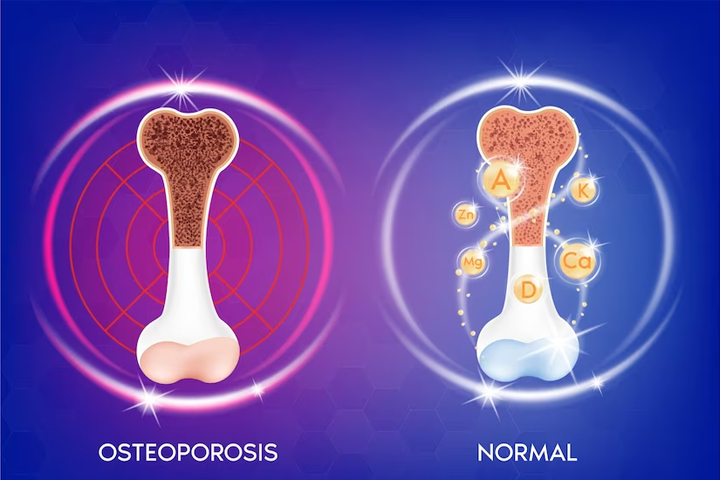April 11, 2023
What is Osteoporosis?
Bone is living tissue that is constantly being broken down and replaced. Osteoporosis occurs when the creation of new bone doesn’t keep up with the removal of old bone. As a result, body loses too much bone, makes too little bone, or both and bones become brittle and fragile, typically as a result of hormonal changes, or deficiency of calcium or vitamin D.
Symptoms of Osteoporosis
It is often called a silent disease because one can’t feel bones weakening. An osteoporotic bone may break from a fall or, in serious cases, from sneezing or minor bumps, which is often the first sign of osteoporosis. Other symptoms a patient may notice are:
- Back pain, caused by a fractured or collapsed vertebra
- Loss of height over time
- Upper back coming forward (A stooped posture)
- A bone fracture that occurs much more easily than expected
Risk factor for Osteoporosis
Number of factors increases the risk to develop osteoporosis including age, sex, race, life style and medications. These risks can be classified as:
Unchangeable risk:
- Sex: female are more prone to osteoporosis than male.
- Age: with increasing age risk of developing osteoporosis is also increased. Post-menopausal women can lose up to 4% of bone mass annually in the first 10 years following menopause.
- Race: white or Asian descent is in high risk of osteoporosis.
- Family history: if parents are osteoporotic patients, risk increases in the next generation.
Hormone levels
Hormones play very important role in bone remodeling. So any changes in certain hormones will increase the risk of osteoporosis.
- Thyroid hormone: Too much thyroid hormone can cause bone loss.
- Sex hormone: Low estrogen level in female and testosterone hormone level in male
- Parathyroid hormone: Overactive parathyroid gland can also lead to osteoporosis
Dietary and life style factors
- Poor absorption due to gastrointestinal disorders
- Low calcium intake
- Restricted eating habit and under weight.
- Smoking and alcohol consumption
- Sedentary life style
Medications and disease conditions
- Steroids, chemotherapy, seizure medications
- Kidney or liver disease, rheumatoid arthritis, inflammatory bowel disease, celiac disease.
How is osteoporosis diagnosed?
A bone density test is the only test that can diagnose osteoporosis before a broken bone occurs. This test helps to estimate the density of your bones and your chance of breaking a bone.
A bone density test tells you if you have normal bone density, low bone density (osteopenia) or osteoporosis. DXA (dual energy x-ray absorptiometry) machine is used to measure bone density to diagnose osteoporosis.
The DXA scan lists results as a “T score.” This measurement is a statistical comparison (SD, or standard deviation) of the patient’s bone density compared to the average peak bone density of a young adult of the same gender and ethnicity.
- A T score of -1 to -2.5 SD is characteristic of osteopenia, which is a precursor to osteoporosis
- A T score of -2.5 SD or below indicates osteoporosis
How Is Osteoporosis Treated and Prevented?
There is no current cure for osteoporosis. Osteoporosis treatment involves stopping further bone loss, and strengthening bones that show signs of weakness.
- Exercise: Physical activities and ‘weight bearing exercises‘ such as walking, climbing stairs and push-ups can improve bone strength.
- Quit smoking and alcohol intake: Smoking increases rates of bone loss and the chance of experiencing a fracture. Consuming more than two alcoholic drinks a day may decrease bone formation.
- Calcium supplements: Men and women between the ages of 18 and 50 need 1,000 milligrams of calcium a day. This daily amount increases to 1,200 milligrams when women turn 50 and men turn 70
- Vitamin D supplements: Vitamin D improves our body’s ability to absorb calcium and improves bone health. For adults calcium up to 600 to 800 international units (IU) a day, through food or supplements is required.
- Hormonal therapy: Estrogen play a role in maintaining bone density and strength in women, many menopausal women with osteoporosis are prescribed hormone therapy including estrogen alone or in combination with progesterone.
- Bisphosphonates and other modern medicines
